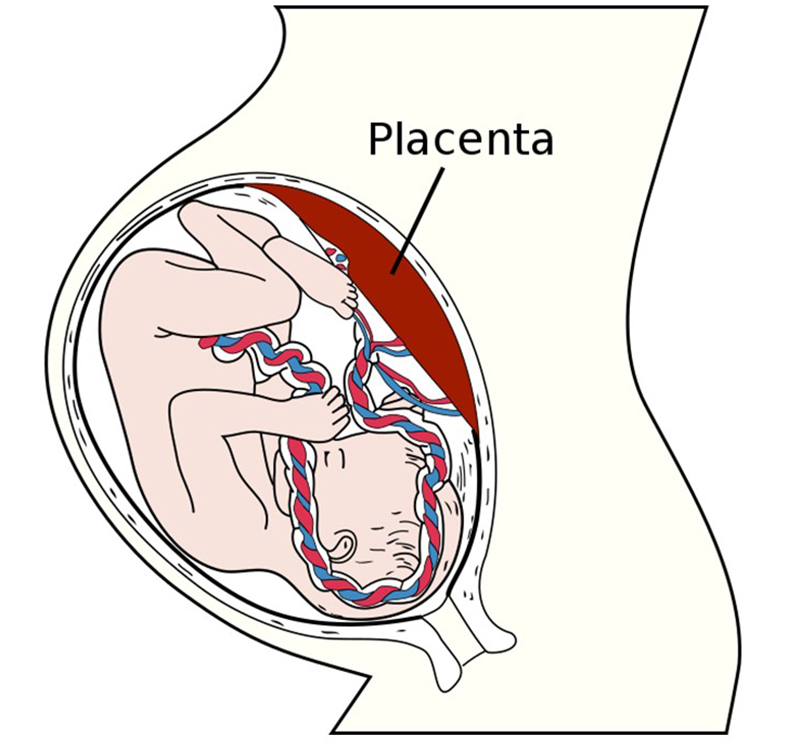

Placental cells secrete extracellular vesicles—tiny, balloon-like structures containing proteins, enzymes, DNA, and other molecules capable of transmitting chemical messages between cells—that appear to help regulate glucose uptake by maternal cells, according to a mouse study funded by the National Institutes of Health. In a series of experiments, the researchers found evidence that release of the vesicles follows placental release of the enzyme O-glycosyl transferase (OGT) after glucose levels rise. The findings may inform the development of new treatments for gestational (pregnancy-related) diabetes.
The study was conducted by Hannah C. Zierden, Ph.D., of the University of Maryland, and colleagues. It appears in Scientific Reports. Funding was provided by NIH’s Eunice Kennedy Shriver National Institute of Child Health and Human Development.
Background
Gestational diabetes refers to high blood sugar that first occurs during pregnancy. Although treatable, it is associated with a higher risk of maternal high blood pressure, large-bodied babies, cesarean delivery (C-section), and low blood sugar in newborns.
Previous studies have found that the placenta releases extracellular vesicles to communicate with maternal cells. Extracellular vesicles released during pregnancy have been associated with implantation of the embryo, activation of the maternal and fetal immune system, formation of new blood vessels, glucose uptake, and the beginning of labor. During pregnancy, the concentration of extracellular vesicles increases three or four times from non-pregnancy levels. In an earlier study, the researchers found that maternal stress reduced the levels of OGT, which senses glucose. Lowering the level of the enzyme also reduced the processing of proteins needed to produce extracellular vesicles.
For the current study, the investigators conducted a series of experiments on how stress and OGT might influence the concentration of extracellular vesicles in the blood of pregnant and non-pregnant mice.
Results
Pregnant mice injected with insulin had a much greater concentration of extracellular vesicles, compared to mice that did not receive an injection.
Extracellular vesicles in the blood of pregnant mice increased markedly throughout pregnancy, while concentrations of extracellular vesicles in the blood of non-pregnant mice remained far lower at corresponding points in time.
In mice under stress, extracellular vesicles decreased at three time points during pregnancy. In a related experiment, researchers treated cultures of human placental cells with the hormone cortisol—produced in response to stress—and the concentration of extracellular vesicles in the cultures also decreased.
The gene for OGT is on the X chromosome, so the placentas of female mouse embryos produce twice as much OGT as male mouse embryos. In another experiment, the researchers estimated the amount of OGT produced in female mice, based on their proportion of female embryos, male embryos, and embryos lacking the gene for OGT. Pregnancies producing the highest total amounts of OGT had the highest concentrations of extracellular vesicles.
In mice as well as in human pregnancies, the ability of the maternal circulation to absorb glucose declines in late pregnancy. Mouse pregnancies having the highest total OGT scores also had the highest concentrations of extracellular vesicles. Although the ability to absorb glucose declined for all the pregnant mice, it declined least for mice having the highest number of extracellular vesicles. The researchers theorized that a rise in OGT and in extracellular vesicles may compensate for the diminished ability to process glucose in late pregnancy.
Significance
The results suggest that placental OGT and extracellular vesicles may play a role in regulating glucose in pregnancy. Similarly, the decline in extracellular vesicles they observed in response to stress, or the stress hormone cortisol, may account for the adverse effects associated with maternal stress during pregnancy, such as preterm birth, gestational diabetes, and preeclampsia.
Reference
Zierden, HC, et al. Extracellular vesicles are dynamic regulators of maternal glucose homeostasis during pregnancy. Scientific Reports. 2021.

 BACK TO TOP
BACK TO TOP